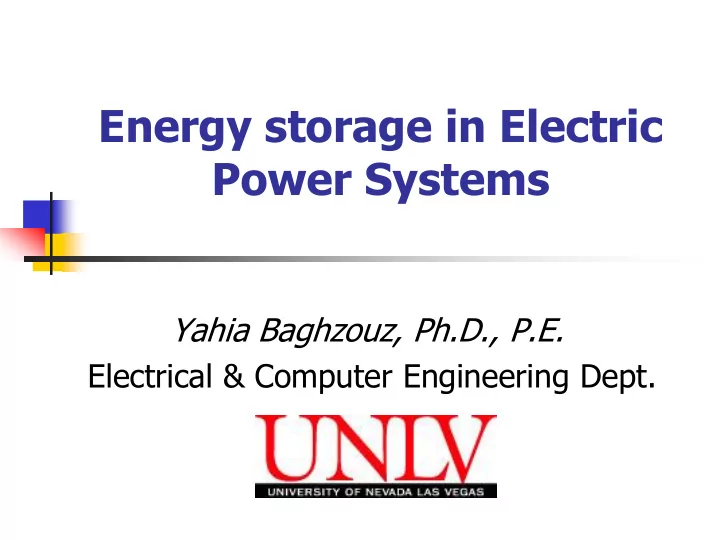

Energy storage in Electric Power Systems Yahia Baghzouz, Ph.D., P.E. Electrical & Computer Engineering Dept.
Overview Impact of variable generation on load curve Energy storage technologies Battery Energy Storage Systems Residential application Commercial application Mobile applications
Adding variable generation (VG) to the mix Solar and wind are excellent sources of clean, renewable energy, but as they contribute a larger share to the generation fleet, their integration will become increasingly challenging. The reason: solar and wind cannot be dispatched in the same way as other sources of energy, such as nuclear, hydro, and fossil fuels. Because the grid must operate “just in time,” with generation continually matching demand, special accommodation is required to integrate a significant contribution from the sun or the wind.
Classification of Energy Storage Systems https://www.energystorageexchange.org/projects
Traditional energy storage: pumped hydro
Classes of Energy Storage The choice of an energy storage device depends on its application in either the current grid or in the renewables/VG-driven grid; these applications are largely determined by the length of discharge.
Advantages of expanded use of energy storage Energy storage can be employed by utilities to facilitate the integration of photovoltaic (PV) generation and mitigate possible negative impacts on the distribution system by: avoiding system upgrades required for PV integration mitigating voltage fluctuations at the primary distribution side resulting from intermittent distributed PV generation reducing distribution system losses through improved utilization of distributed generation deferring upgrade of substation equipment by time-shifting peak PV generation to coincide with system load peak
Energy Storage Applications
Deferral of Distribution Feeder investment
Expected Growth in U.S. Annual Energy Storage Deployments
Energy Storage Policies in US Several states have recently introduced policies related to the support and development of energy storage technology markets.
A 34-MW, 245-MWh Na-S battery installation in Japan
Tehachapi wind farm (Capacity: 4,500 MW)
Large-Scale BESS Installations 32 MWH BESS features lithium-ion batteries housed inside a substation in Tehachapi, CA.
Distributed Energy BESS
Community Energy Storage (multiple customers) Typical CES Power and Energy Ratings 25 kW 50 kWh
Residential Applications (single customer) Typical Power and Energy Ratings: 2-5 kW 5-15 kWh
Bombard – Adera Power (Las Vegas, NV) PV-BESS expected to expand as power exported to the grid is becoming less and less costly.
Testing of a BES for Residential Applications Part of DOE Smart Grid Demo Projects Collaborators: NV Energy and Pulte Homes
Adding a Battery Energy Storage System to the Mix 4.5 kW/10 kWh Residential BESS
Charge/Discharge Test
Round trip efficiency
Application 1: Customer enrolled in TOU pricing Battery saves money by reducing consumption during periods when total demand for electricity is highest (1:00pm-7:00pm, June-September) Battery shifts part of load from (1:00pm-7:00pm) to (12:00am-6:00am)
Application 2: Keep Maximum Demand Below 3 kW Use battery to provide power demand above 3 kW limit. Use excess PV power to charge battery
Charging/discharging optimization [x] Different electricity rate plans Payback period exceeds over 10 years (without incentives) [x] X. Wang, G.G. Karaday, “Hybrid Battery Charging Strategy for Maximizing PV Customers’ Economic Benefits, IEEE PES GM 2016
PV Power Smoothing Energy storage system integration with PV can be designed to operate in many ways such as: PV Power Firming: Level PV output power during cloud transients throughout the day, then gets recharged at night and be ready for the next day. PV Power Smoothing: the storage system will generate and absorb energy to smooth out PV array power fluctuations. The next slides evaluate the placement of an BES at the PCC of a commercial-size Concentrating PV system for the purpose of reducing the ramp rate, or 27 “power smoothing”.
PV Plant Description Power rating: 55 kW. Surface 300 m 2 No. of cells: 5,600 Type of cell: III-V multi- junction Concentration factor: 500 Cell efficiency: 25% 28
Power production during 20-minute period of passing clouds 29
P OWER R AMP R ATE (KW/S EC ) 30
Power Smoothing by BES Reducing power fluctuations depends to several factors such as desired power quality, PV system location in the feeder and specific controls of voltage regulation equipment. Ramp rate control (or smoothing) by means of a BES is achieved by continuously monitoring the PV power output and commanding the BES to charge or discharge in a way that limits the combined PV-BES power. 31
Power Smoothing by BES For ramp rate control, the method based on moving average (MA) provides satisfactory results as it defines the current direction with a lag because it is based on past power values. The BES is to supply a power P e,n+1 that is equal to the deference between the updated moving average and the new PV power generated, i.e., ( 1 ) n P P , 1 1 s n s P P P P , 1 , 1 , 1 e n s n s n sn 32 n
Power Variability of CPV-BES Combination 33 .
P OWER R AMP R ATE OF CPV-BES C OMBINATION 34
BES S IZING 35 300 Wh/1.25 kW (for 1 min moving average) 160 Wh/1.5 kW (for ½ min moving average)
Typical battery charging curve What if recommended charge curve is not followed? What is the impact of shallow discharges?
Battery discharge curves Battery capacity under variable discharge rate?
Lastly ….testing a lemon battery! Zinc Copper 4 lemons can power one a bright LED for over 24 hrs!
Recommend
More recommend